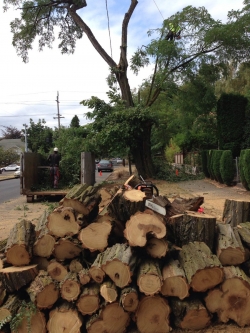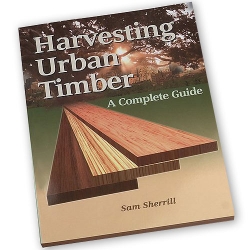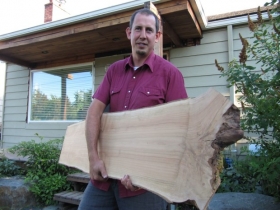Is it time for the greenspaces movement to embrace urban lumber?
David Barmon, December 18 2013
 With proper equipment, winching a few black walnut logs out of a Southeast Portland backyard should take 30 minutes. It took my buddy Daniel and I, new to urban timber harvesting, upwards of 11 hours. Or then there was the time a hidden chunk of metal buried in three deodar cedar logs -- removed from a landscape project near Grant High School -- chewed up another friend’s sawmill blades.
With proper equipment, winching a few black walnut logs out of a Southeast Portland backyard should take 30 minutes. It took my buddy Daniel and I, new to urban timber harvesting, upwards of 11 hours. Or then there was the time a hidden chunk of metal buried in three deodar cedar logs -- removed from a landscape project near Grant High School -- chewed up another friend’s sawmill blades.
Urban lumber isn’t always easy. So why have my friends and I committed to saving these logs from the fireplace?
Every year in the U.S., an estimated 4 billion board feet of urban trees are cut up for firewood, mulched, or taken to the dump. Yes, urban trees often have defects: large knots and metal embedded in the wood, for example. But at the end of the day, a lot of existing urban trees DO produce high quality saw logs. To me and my partners at Fiddlehead LLC, it seems immoral to value our urban trees while they’re living but then discard the deadwood so casually.
Across the globe, from Portland to Rio de Janeiro, lumber-producing trees can grow well in urban and semi rural areas. Through my work, I've seen many valuable older trees destroyed, and new trees improperly pruned and then relegated to the same fate. That's how I became an advocate for holistic urban lumber planning (click here for my podcast) -- so that every tree, when it comes down, plays a new role as a valuable building material, rather than firewood and mulch.
Planning for urban lumber isn’t simply an extension of current practices: it means planting more trees closer together, and removing the lower branches to prevent knots. And, of course, not sticking metal into the trees would be helpful as well.
 In 50 years -- with smart policies in place and a shift in our culture -- I believe we could produce a decent percentage of lumber we use across the world right here, in sustainably managed forests where we live.
In 50 years -- with smart policies in place and a shift in our culture -- I believe we could produce a decent percentage of lumber we use across the world right here, in sustainably managed forests where we live.
New policies and operations emerging from the global greenspaces movement will strongly influence how trees are utilized in the future. It’s time embrace a holistic and integrated approach to urban lumber. My view is that The Intertwine Alliance and its 100+ partners could play a role in sparking this conversation -- to reforest land and significantly shrink the carbon footprint of our built environment.
 This year, Daniel and I have leased land in Charbonneau and are starting to collect logs to mill. Daniel is building a slabbing mill so we can make large diameter tables from the 4' and 5' diameter logs we’ve collected from sites around Northeast Portland. In the last few weeks I have begun gluing up deodar cedar and black walnut for tables and benches -- furniture made from beautiful, valuable wood with a very personal story. We need more of these kinds of connections in the world.
This year, Daniel and I have leased land in Charbonneau and are starting to collect logs to mill. Daniel is building a slabbing mill so we can make large diameter tables from the 4' and 5' diameter logs we’ve collected from sites around Northeast Portland. In the last few weeks I have begun gluing up deodar cedar and black walnut for tables and benches -- furniture made from beautiful, valuable wood with a very personal story. We need more of these kinds of connections in the world.

 David Barmon co-owns
David Barmon co-owns
Add new comment